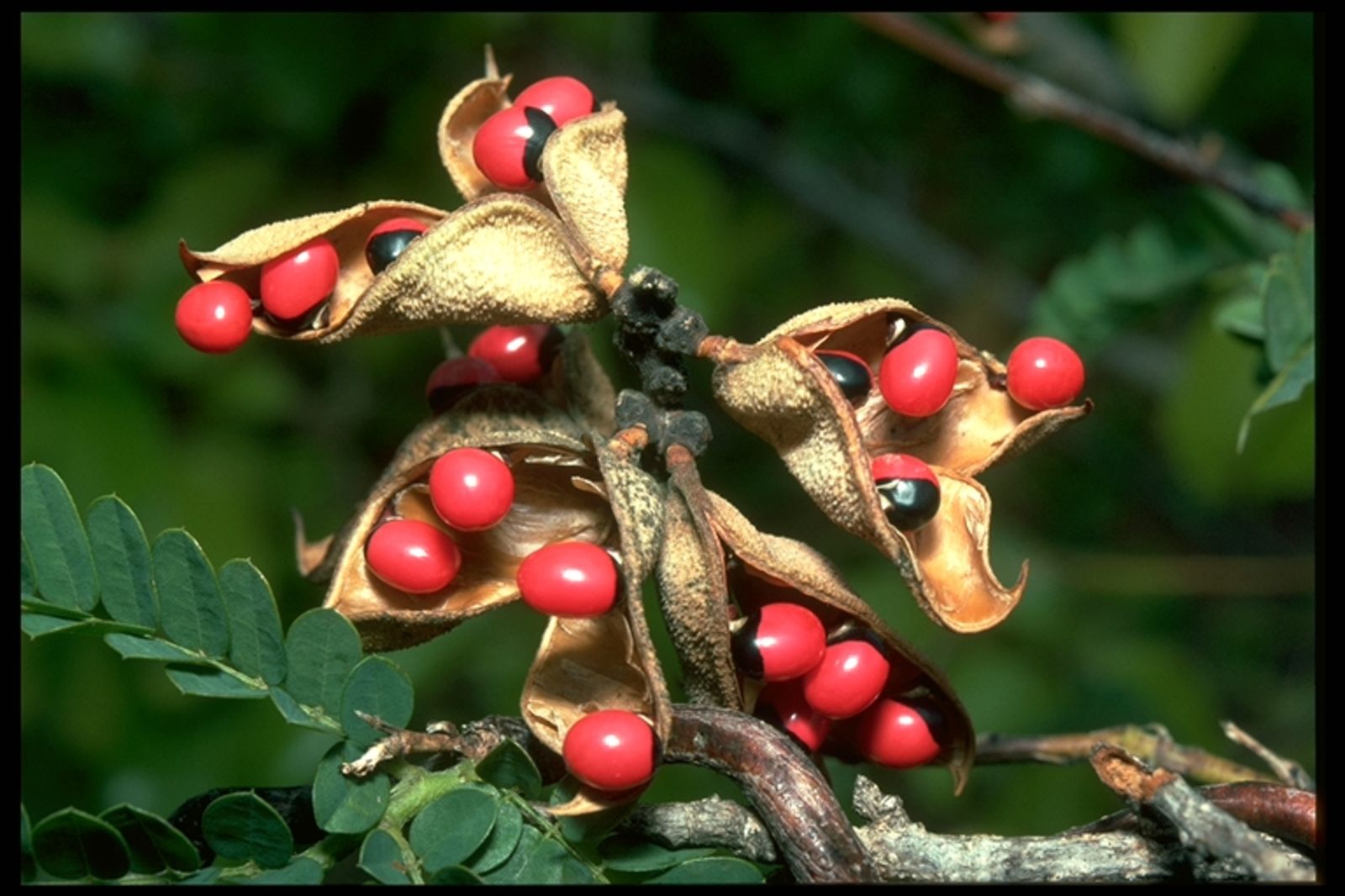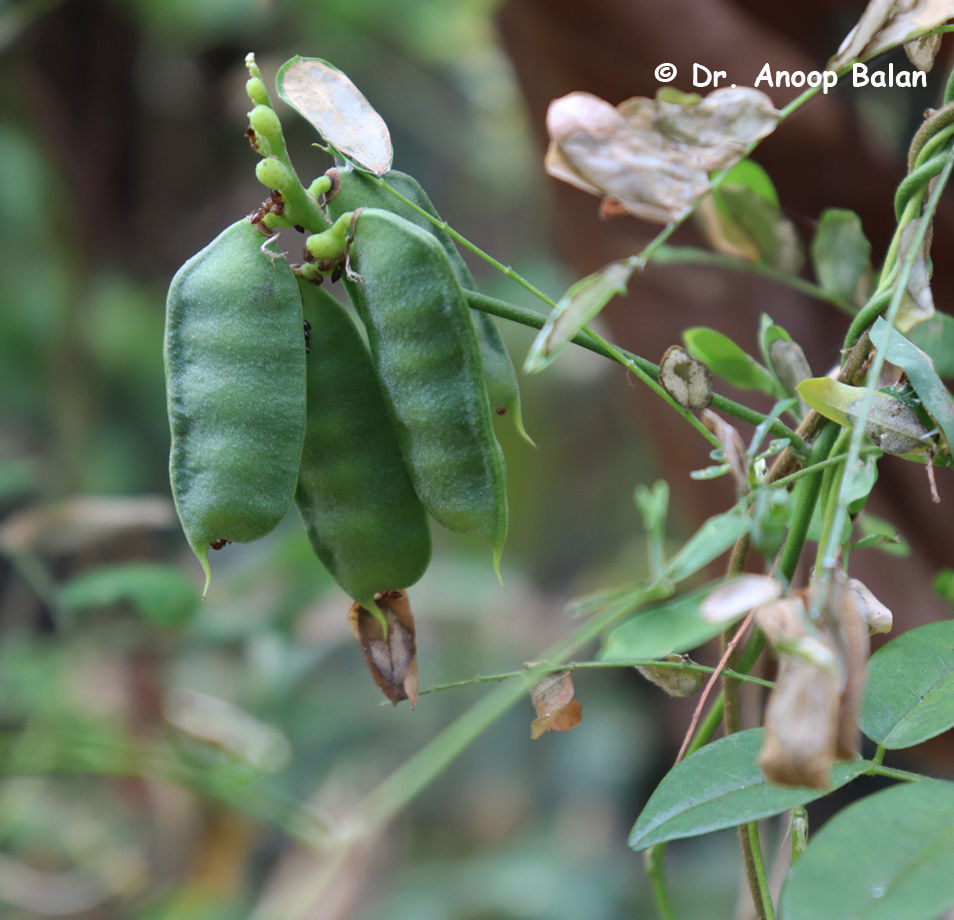Jequirity bean, Crab's eye, Rosary pea
abrus precatorius
Also known as: ["Jequirity bean","Crab's eye","Rosary pea","Indian licorice","Preclara"]
Overview
A tropical legume known for its highly toxic seeds, which are often used in jewelry and traditional crafts.
Benefits & Perks
["aesthetic foliage","rare/collector’s item"]
Botanical Classification
| Phylum: | Magnoliophyta |
| Class: | Magnoliopsida |
| Order: | Fabales |
| Family: | Fabaceae |
| Genus: | Abrus |
| Botanical Name: | Abrus precatorius |
Plant Characteristics
Basic Information
- Category: Shrubs
- Suitable Location: indoor pot or sheltered outdoor area
- Suitable For:
- Is Weed: No
- Allergenicity: low
Environmental Needs
- Climate: {"temperatureRange":"15–35°C"}
- Hardiness: {"zones":"9–11"}
- Misting: every 2–3 days in dry conditions
- Drainage: Fast-draining to prevent root rot.
- Soil Type: Well-draining potting mix with added perlite or sand for aeration.
Maintenance Level
- Maintenance Level: moderate
- Toughness Level: moderate
- Pruning Frequency: Every 2–3 months during growing season; light pruning can be done as needed.
- Pruning Intensity: Moderate; remove up to one-third of growth if necessary, but avoid heavy pruning in winter.
Care Details
Ideal Sunlight Coverage:
Bright indirect light for 6–8 hours daily; can tolerate some direct morning sun but avoid harsh afternoon sun.
Sunlight Tolerance Tips:
Gradually acclimate to direct sun to prevent scorching; place in a spot with filtered light if outdoors; indoors, position near an east or west-facing window.
Care Requirements
Care Difficulty
moderatemoderate
Sunlight
full sun to partial shade
Rotate plant weekly for even growth; use sheer curtains to filter intense light; avoid placing near south-facing windows in summer.
Watering
every 7–10 days during active growth, reduce in winter
Water thoroughly until it drains from the bottom, allow soil to dry between waterings, avoid wetting foliage to prevent fungal issues.
Soil
well-draining, sandy loam with organic matter
pH: Slightly acidic to neutral, pH 6.0–7.0.
Ensure pots have drainage holes; avoid heavy clay soils; top-dress with compost annually.
Temperature
Prefers warm conditions, 65–85°F (18–29°C); sensitive to cold, avoid temperatures below 50°F (10°C).
Avoid sudden temperature fluctuations; protect from cold drafts; maintain stable warmth during winter.
Fertilizing
every 4–6 weeks during growing season
Flush soil occasionally to prevent salt buildup; apply fertilizer after watering to avoid root burn; stop fertilizing when plant is dormant.
Propagation
Methods
Stem cuttings in water or soil.
Step-by-Step Propagation Guide
- Take a 4–6 inch cutting, remove lower leaves, dip in rooting hormone (optional), place in medium, keep moist and warm.
Best Time: Spring or early summer when the plant is actively growing.
Environment
Warm, humid environment with indirect light; maintain 70–80°F (21–27°C) and high humidity.
Medium
Well-draining soil mix or water with occasional changes.
Hormone
Optional but recommended for faster rooting.
Timeline
Roots typically form in 2–4 weeks; new growth may take 1–2 months.
Tools Needed
Pruning shears, rooting hormone, small pots, well-draining soil or water container.
Quick Tips
Use healthy, non-flowering stems; keep cuttings out of direct sun; maintain consistent moisture.
Pruning & Repotting
Pruning Guide
Method
Selective pruning of stems to shape plant; pinch back tips to encourage branching.
Pruning Plan
Prune to maintain shape, encourage bushier growth, and remove dead or overgrown stems.
Tools
Clean, sharp pruning shears or scissors.
Checklist
Sanitize tools, prune dead/damaged growth, shape plant, wear gloves (toxic sap), dispose of clippings safely.
Repotting Guide
Best Season
Spring, before the active growing season begins.
Pot Size
Increase pot size by 1–2 inches in diameter; avoid oversized pots to prevent waterlogging.
Method
Remove plant gently, trim roots if crowded, place in a slightly larger pot with fresh soil, ensure good drainage.
Suggestions
Repot every 2–3 years or when roots fill the pot; necessary to refresh soil and provide space for growth.
Checklist
Choose right pot, prepare new soil, trim roots if needed, water after repotting, place in appropriate light.
Advanced Care Tips
Watering Mastery
Watering Checklist
Check soil moisture, water thoroughly, ensure drainage, avoid wetting leaves, adjust for season.
How to Apply Water Properly
Water directly at the root zone, ensuring even saturation to a depth of 6–8 inches, allow excess water to drain fully, water in the morning to reduce evaporation and fungal risk.
Watering Schedule Tips
Water deeply once the top inch of soil is dry; reduce frequency in winter to prevent root rot.
Soil Improvement
Add perlite, coarse sand, or orchid bark to improve drainage; incorporate compost for fertility.
Temperature Stress Management
Signs of Temperature Issues
Chlorosis (yellowing leaves), leaf drop, stunted growth, or browning leaf edges.
Cold Stress
Low temperatures slow growth, cause leaf drop, and may lead to root rot if soil remains cold and wet.
Solution: Move plant to a warmer location, protect from drafts, reduce watering, and use a heat mat if necessary.
Hot Stress
Excessive heat can cause leaf scorch, wilting, and dehydration, especially if combined with low humidity.
Solution: Provide shade during peak heat, increase humidity with misting or a humidifier, and ensure consistent watering.
Fertilizing Guide
Fertilizing Checklist
Check season, dilute fertilizer, water before feeding, apply to soil, rinse pot periodically.
Fertilizing Method
Use a balanced liquid fertilizer diluted to half strength every 4–6 weeks during growing season (spring/summer); avoid fertilizing in fall/winter.
Common Problems & Solutions
Toxicity Warning
Cats
Highly ToxicAbrus precatorius is highly toxic to cats, with abrin posing a significant risk even in small doses. Ingestion can result in severe poisoning, affecting multiple organ systems and potentially leading to fatal outcomes.
⚠️ Symptoms:
🌿 Toxic Parts:
⚡ Toxic If:
if eaten
Dogs
Highly ToxicAbrus precatorius is extremely toxic to dogs due to the presence of abrin. Ingestion can cause severe poisoning, leading to gastrointestinal distress, systemic toxicity, and potentially fatal outcomes.
⚠️ Symptoms:
🌿 Toxic Parts:
⚡ Toxic If:
if eaten
Humans
Highly ToxicAbrus precatorius contains abrin, a potent ribosome-inhibiting protein that is highly toxic even in small quantities. Ingestion can lead to severe gastrointestinal, cardiovascular, and neurological effects, potentially resulting in organ failure and death.
⚠️ Symptoms:
🌿 Toxic Parts:
⚡ Toxic If:
if eaten
Frequently Asked Questions
Q: Are Abrus precatorius seeds safe to handle?
A: No, the seeds are highly toxic and should not be handled without protective gloves.
Q: Can Abrus precatorius be grown indoors?
A: It is primarily an outdoor plant due to its toxicity and growth habits.
Q: What are the traditional uses of Abrus precatorius?
A: The seeds are traditionally used in jewelry and crafts, while the plant has some medicinal applications in folk medicine.
Quick Reference
| Family: | Fabaceae |
| Care: | moderate |
| Light: | full sun to partial shade |
| Water: | every 7–10 days during activ |
Get Expert Care Tips
Download the Plantious app for personalized care reminders and plant identification!
Google Play App Store








